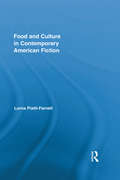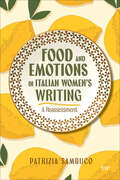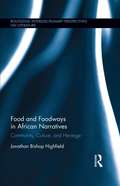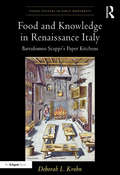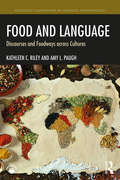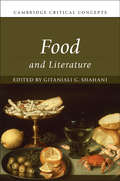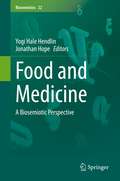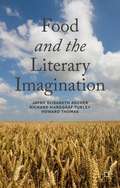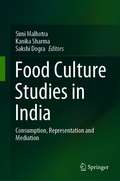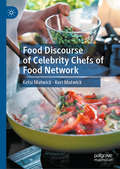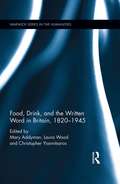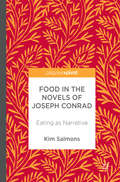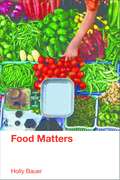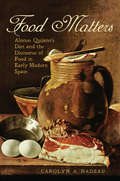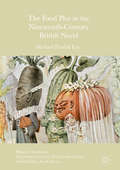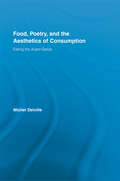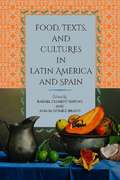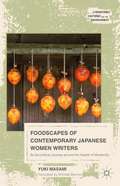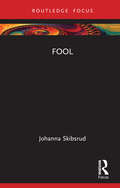- Table View
- List View
Food and Culture in Contemporary American Fiction (Routledge Studies in Contemporary Literature)
by Lorna Piatti-FarnellEstablishing an interdisciplinary connection between Food Studies and American literary scholarship, Piatti-Farnell investigates the significances of food and eating in American fiction, from 1980 to the present day. She argues that culturally-coded representations of the culinary illuminate contemporary American anxieties about class gender, race, tradition, immigration, nationhood, and history. As she offers a critical analysis of major works of contemporary fiction, Piatti-Farnell unveils contrasting modes of culinary nostalgia, disillusionment, and progress that pervasively address the cultural disintegration of local and familiar culinary values, in favor of globalized economies of consumption. In identifying different incarnations of the "American culinary," Piatti-Farnell covers the depiction of food in specific categories of American fiction and explores how the cultural separation that molds food preferences inevitably challenges the existence of a homogenous American identity. The study treads on new grounds since it not only provides the first comprehensive study of food and consumption in contemporary American fiction, but also aims to expose interrelated politics of consumption in a variety of authors from different ethnic, cultural, racial and social backgrounds within the United States.
Food and Emotions in Italian Women's Writing: A Reassessment (Toronto Italian Studies)
by Patrizia SambucoFood and Emotions in Italian Women’s Writing discusses the relevance of food imagery in the writing of Italian women over a period of one hundred years, from the 1920s to the present day, while offering new ways to narrate women’s history and creativity. In this groundbreaking work, Patrizia Sambuco shows how food imagery in different historical periods challenge established political discourses by conveying unexpressed, alternative, or transgressive emotions. Through literary analysis, archival research, and philosophical approaches to the senses, emotions, and food, the book considers a variety of authors, from the celebrated to the hardly known. Sambuco argues that in different ways, throughout the decades, the conceptual domain of food has helped express forms of selfhood that push the boundaries of womanhood and interact with cultural and political panoramas at national and international levels. Building an alternative history of Italian women and their creativity, Sambuco shows how the interplay of the senses and emotions becomes a profitable way to illuminate overlooked aspects of women’s subjectivity. Food and Emotions in Italian Women's Writing ultimately reassesses women’s writing, giving value to the marginality of women’s bodies and positions through the conceptual domain of food.
Food and Femininity in Twentieth-Century British Women's Fiction
by Andrea AdolphIn her feminist intervention into the ways in which British women novelists explore and challenge the limitations of the mind-body binary historically linked to constructions of femininity, Andrea Adolph examines female characters in novels by Barbara Pym, Angela Carter, Helen Dunmore, Helen Fielding, and Rachel Cusk. Adolph focuses on how women's relationships to food (cooking, eating, serving) are used to locate women's embodiment within the everyday and also reveal the writers' commitment to portraying a unified female subject. For example, using food and food consumption as a lens highlights how women writers have used food as a trope that illustrates the interconnectedness of sex and gender with issues of sexuality, social class, and subjectivity-all aspects that fall along a continuum of experience in which the intellect and the physical body are mutually complicit. Historically grounded in representations of women in periodicals, housekeeping and cooking manuals, and health and beauty books, Adolph's theoretically informed study complicates our understanding of how women's social and cultural roles are intricately connected to issues of food and food consumption.
Food and Foodways in African Narratives: Community, Culture, and Heritage (Routledge Interdisciplinary Perspectives on Literature)
by Jonathan Bishop HighfieldFood is a defining feature in every culture. Despite its very basic purpose of sustaining life, it directly impacts the community, culture and heritage in every region around the globe in countless seen and unseen ways, including the literature and narratives of each region. Across the African continent, food and foodways, which refer to the ways that humans consume, produce and experience food, were influened by slavery and forced labor, colonization, foreign aid, and the anxieties prompted by these encounters, all of which can be traced through the ways food is seen in narratives by African and colonial storytellers. The African continent is home to thousands of cultures, but nearly every one has experienced alteration of its foodways because of slavery, transcontinental trade, and colonization. Food and Foodways in African Narratives: Community, Culture, and Heritage takes a careful look at these alterations as seen through African narratives throughout various cultures and spanning centuries.
Food and Knowledge in Renaissance Italy: Bartolomeo Scappi's Paper Kitchens (Visual Culture In Early Modernity Ser.)
by Deborah L KrohnThough Bartolomeo Scappi's Opera (1570), the first illustrated cookbook, is well known to historians of food, up to now there has been no study of its illustrations, unique in printed books through the early seventeenth century. In Food and Knowledge in Renaissance Italy, Krohn both treats the illustrations in Scappi's cookbook as visual evidence for a lost material reality; and through the illustrations, including several newly-discovered hand-colored examples, connects Scappi's Opera with other types of late Renaissance illustrated books. What emerges from both of these approaches is a new way of thinking about the place of cookbooks in the history of knowledge. Krohn argues that with the increasing professionalization of many skills and trades, Scappi was at the vanguard of a new way of looking not just at the kitchen-as workshop or laboratory-but at the ways in which artisanal knowledge was visualized and disseminated by a range of craftsmen, from engineers to architects. The recipes in Scappi's Opera belong on the one hand to a genre of cookery books, household manuals, and courtesy books that was well established by the middle of the sixteenth century, but the illustrations suggest connections to an entirely different and emergent world of knowledge. It is through study of the illustrations that these connections are discerned, explained, and interpreted. As one of the most important cookbooks for early modern Europe, the time is ripe for a focused study of Scappi's Opera in the various contexts in which Krohn frames it: book history, antiquarianism, and visual studies.
Food and Language: Discourses and Foodways across Cultures
by Kathleen C. Riley Amy L. PaughFood and Language: Discourses and Foodways across Cultures explores in innovative ways how food and language are intertwined across cultures and social settings. How do we talk about food? How do we interact in its presence? How do we use food to communicate? And how does social interaction feed us? The book assumes no previous linguistic or anthropological knowledge but provides readers with the understanding to pursue further research on the subject. With a full glossary at the end of the book and additional tools hosted on an eResources page (such as recommended web and video links and some suggested research exercises), this book serves as an ideal introduction for courses on food, language, and food-and-language in anthropology departments, linguistics departments, and across the humanities and social sciences. It will also appeal to any reader interested in the semiotic interplay between food and language.
Food and Literature (Cambridge Critical Concepts)
by Gitanjali G. ShahaniThis volume examines food as subject, form, landscape, polemic, and aesthetic statement in literature. With essays analyzing food and race, queer food, intoxicated poets, avant-garde food writing, vegetarianism, the recipe, the supermarket, food comics, and vampiric eating, this collection brings together fascinating work from leading scholars in the field. It is the first volume to offer an overview of literary food studies and reflect on its origins, developments, and applications. Taking up maxims such as 'we are what we eat', it traces the origins of literary food studies and examines key questions in cultural texts from different global literary traditions. It charts the trajectories of the field in relation to work in critical race studies, postcolonial studies, and children's literature, positing an omnivorous method for the field at large.
Food and Medicine: A Biosemiotic Perspective (Biosemiotics #22)
by Yogi Hale Hendlin Jonathan HopeThis edited volume provides a biosemiotic analysis of the ecological relationship between food and medicine. Drawing on the origins of semiotics in medicine, this collection proposes innovative ways of considering aliments and treatments. Considering the ever-evolving character of our understanding of meaning-making in biology, and considering the keen popular interest in issues relating to food and medicines - fueled by an increasing body of interdisciplinary knowledge - the contributions here provide diverse insights and arguments into the larger ecology of organisms’ engagement with and transformation through taking in matter. Bodies interpret molecules, enzymes, and alkaloids they intentionally and unintentionally come in contact with according to their pre-existing receptors. But their receptors are also changed by the experience. Once the body has identified a particular substance, it responds by initiating semiotic sequences and negotiations that fulfill vital functions for the organism at macro-, meso-, and micro-scales. Human abilities to distill and extract the living world into highly refined foods and medicines, however, have created substances far more potent than their counterparts in our historical evolution. Many of these substances also lack certain accompanying proteins, enzymes, and alkaloids that otherwise aid digestion or protect against side-effects in active extracted chemicals. Human biology has yet to catch up with human inventions such as supernormal foods and medicines that may flood receptors, overwhelming the body’s normal satiation mechanisms. This volume discusses how biosemioticians can come to terms with these networks of meaning, providing a valuable and provocative compendium for semioticians, medical researchers and practitioners, sociologists, cultural theorists, bioethicists and scholars investigating the interdisciplinary questions stemming from food and medicine.
Food and the Literary Imagination
by Jayne Elisabeth ArcherFood and the Literary Imagination explores ways in which the food chain and anxieties about its corruption and disruption are represented in poetry, theatre and the novel. The book relates its findings to contemporary concerns about food security.
Food, Consumption, and Masculinity in American Hardboiled Fiction (Crime Files)
by Marta UsiekniewiczFood, Consumption, and Masculinity in American Hardboiled Fiction draws on three related bodies of knowledge: crime fiction criticism, masculinity studies, and the cultural analysis of food and consumption practices from a critical eating studies perspective. In particular, this book focuses on food as an analytical category in the study of tough masculinity as represented in American hardboiled fiction. Through an examination of six American novels: Dashiell Hammett's The Maltese Falcon, Raymond Chandler's The Big Sleep, Leigh Brackett's No Good from a Corpse, Dorothy B. Hughes's In a Lonely Place, Jim Thompson's The Killer Inside Me, and Rex Stout's Champagne for One, this book shows how these novels reflect the gradual process of redefining consumption and consumerism in America, which traditionally has been coded as feminine. Marta Usiekniewicz shows that food and eating also reflect power relations and larger social and economic structures connected to class, gender, geography, sexuality, and ability, to name just a few.
Food Culture Studies in India: Consumption, Representation and Mediation
by Simi Malhotra Kanika Sharma Sakshi DograThis book discusses food in the context of the cultural matrix of India. Addressing topical issues in food and food culture, it explores questions concerning the consumption, representation and mediation of food. The book is divided into four sections, focusing on food fads; food representation; the symbolic valence of food; modes and manners of resistance articulated through food. Investigating consumption practices in both public and ethnic culture, each chapter introduces a fresh approach to food across diverse literary and cultural genres. The book offers a highly readable guide for researchers and practitioners in the field of literary and cultural studies, as well as the sociological fields of food studies, body studies and fat studies.
Food Discourse of Celebrity Chefs of Food Network
by Kelsi Matwick Keri MatwickFood Discourse explores a fascinating, yet virtually unexplored research area: the language of food used on television cooking shows. It shows how the discourse of television cooking shows on the American television channel Food Network conveys a pseudo-relationship between the celebrity chef host and viewers. Excerpts are drawn from a variety of cooking show genres (how-to, travel, reality, talk, competition), providing the data for this qualitative investigation. Richly interdisciplinary, the study draws upon discourse analysis, narrative, social semiotics, and media communication in order to analyze four key linguistic features – recipe telling, storytelling, evaluations, and humor – in connection with the themes of performance, authenticity, and expertise, essential components in the making of celebrity chefs. Given its scope, the book will be of interest to scholars of linguistics, media communication, and American popular culture. Further, in light of the international reach and influence of American television and celebrity chefs, it has a global appeal.
Food, Drink, and the Written Word in Britain, 1820-1945 (Warwick Series in the Humanities)
by Mary Addyman Laura Wood Christopher YiannitsarosThis volume explores the intersection between culinary history and literature across a period of profound social and cultural change. Split into four parts, essays focus on the relationships between eating and childhood reading in the Victorian era, the role of hunger in depicting social instability and reform, the cultivation of taste through advertising and the formation of cultural legacies through imaginative and emotional experiences of food and drink. Contributors show that studying consumption is necessary for a full understanding of class, gender, national identity and the body. The works of writers such as Elizabeth Gaskell, Edward Lear, Isabella Beeton and Bram Stoker are considered alongside advice manuals, Home Front narratives and advertising to provide an innovative work that will be of interest to scholars of social, cultural and medical history as well as literary studies.
Food in Margaret Atwood’s Speculative Fiction
by Katarina LabudovaThis book looks at Margaret Atwood’s use of food motifs in speculative fiction. Focusing on six novels – The Handmaid’s Tale and The Testaments, the Maddaddam trilogy, and The Heart Goes Last – Katarina Labudova explores the environmental, ecological, and cultural questions at play and the possible future scenarios which emerge for humanity’s survival in apocalyptic and post-apocalyptic conditions. Labudova argues that food has special relevance in these novels and that characters’ hunger, limited food choices, culinary creativity and eating rituals are central to Atwood’s depictions of hostile environments. She also links food to hierarchy, dominance and oppression in Atwood’s novels, and foregrounds the problem of hunger, both psychological or physical, caused by pollution and loss of contact with the natural and authentic. The book shows how Atwood’s writing draws from a range of genres, including apocalyptic fiction, science fiction, speculative fiction, dystopia, utopia, fairy tale, myth, and thriller – and how food is an important, highly versatile motif linking these intertextual threads.
Food in Shakespeare: Early Modern Dietaries and the Plays (Literary And Scientific Cultures Of Early Modernity Ser.)
by Joan FitzpatrickA study of common and exotic food in Shakespeare's plays, this is the first book to explore early modern English dietary literature to understand better the significance of food in Shakespearean drama. Food in Shakespeare provides for modern readers and audiences an historically accurate account of the range of, and conflicts between, contemporary ideas that informed the representations of food in the plays. It also focuses on the social and moral implications of familiar and strange foodstuff in Shakespeare's works. This new approach provides substantial fresh readings of Hamlet, Macbeth, As you Like It, The Winter's Tale, Henry IV Parts 1 and 2, Henry V, Titus Andronicus, Coriolanus, Pericles, Timon of Athens, and the co-authored Sir Thomas More. Among the dietaries explored are Andrew Boorde's A Compendyous Regyment or a Dyetary of Healthe (1547), William Bullein's The Gouernement of Healthe (1595), Thomas Elyot's The Castle of Helthe (1595) and Thomas Cogan's The Hauen of Health (1636). These dieteries were republished several times in the early modern period; together they typify the genre's condemnation of surfeit and the tendency to blame human disease on feeding practices. This study directs scholarly attention to the importance of early modern dietaries, analyzing their role in wider culture as well as their intersection with dramatic art. In the dietaries food and drink are indices of one's position in relation to complex ideas about rank, nationality, and spiritual well-being; careful consumption might correct moral as well as physical shortcomings. The dietaries are an eclectic genre: some contain recipes for the reader to try, others give tips on more general lifestyle choices, but all offer advice on how to maintain good health via diet. Although some are more stern and humourless than others, the overwhelming impression is that of food as an ally in the battle against disease and ill-health as well as a potential enemy.
Food in the Middle Ages: A Book of Essays (Medieval Casebooks Series #12)
by Melitta Weiss AdamsonFirst Published in 1995. Routledge is an imprint of Taylor & Francis, an informa company.
Food in the Novels of Joseph Conrad
by Kim SalmonsThis book is about the role of food in the works of Joseph Conrad, analysing the social, political and anthropological context of references to meals, eating, food production and cannibalism. It offers a new perspective on the works of Joseph Conrad and provides an accessible medium through which readers can engage with the complex theories and philosophical dilemmas that Conrad presents in his fiction. This is the only major study of food in Conrad's works; it is unique in its interdisciplinary approach to food in that it engages with sociological, political, historical, personal and literary perspectives, thus providing a multi-dimensional approach to cultural, revolutionary, periodical and fictional representations of the late nineteenth and early twentieth centuries. This in turn, allows an interrogation of modern anxieties, embedded in cultural norms and values that can be interpreted through the way that food is prepared and eaten.
Food Matters
by Holly BauerFood Matters, Second Edition, explores questions about the seemingly simple concept of food: What is the purpose of food: sustenance, pleasure, health? How does what we eat determine and reflect our identities? What political, social, and cultural forces affect our food choices? What does it mean to eat ethically? What is food, exactly, and how do advances in technology affect our definition of it? Readings by a range of essayists, scientists, linguists, journalists, farmers, artists, and ordinary citizens take up these questions and more. Questions and assignments for each selection provide a range of activities for students. This new edition of Food Matters features current readings that reflect the evolving conversation about food in our society. The Bedford Spotlight Reader Series is an exciting line of single-theme readers, each reflecting Bedford’s trademark care and quality. An editorial board of a dozen compositionists at schools with courses focusing on specific themes assists in the development of the series. Each reader collects thoughtfully chosen selections sufficient for an entire writing course—about 35 pieces—to allow instructors to provide carefully developed, high-quality instruction at an affordable price. Bedford Spotlight Readers are designed to help students from all majors make sustained inquiries from multiple perspectives, opening up topics such as money, food, border crossings, music, humor, subcultures, happiness, monsters, sustainability, and gender to critical analysis. The readers are flexibly arranged in thematic chapters, with each chapter focusing in depth on a different facet of the central topic. The website for the Spotlight Series offers comprehensive instructor support with sample syllabi and additional teaching resources.
Food Matters: Alonso Quijano's Diet and the Discourse of Food in Early Modern Spain
by Carolyn A. NadeauIn the second sentence of Don Quixote, Cervantes describes the diet of the protagonist, Alonso Quijano: "A stew made of more beef than mutton, cold salad on most nights, abstinence eggs on Saturdays, lentils on Fridays, and an additional squab on Sundays."Through an inventive and original engagement with this text, Carolyn A. Nadeau explores the shifts in Spain's cultural and gastronomic history. Using cooking manuals, novels, poems, dietary treatises, and other texts, she brings to light the figurative significance of foodstuffs and culinary practices in early modern Spain. Drawing on the work of Pierre Bourdieu and Stephen Mennell, Food Matters reveals patterns of interdependence as observed, for example, in how Muslim and Jewish aversion to pork fired Spain's passion for ham, what happened when New World foodstuffs entered into Old World kitchens, and how food and sexual urges that so often came together, regardless of class, ethnicity, or gender, construct moments of communal celebration.This mouth-watering tour of the discourses of food in early modern Spain is complemented by an appendix that features forty-seven recipes drawn from contemporary sources.
The Food Plot in the Nineteenth-Century British Novel
by Michael Parrish LeeThis book is about food, eating, and appetite in the nineteenth-century British novel. While much novel criticism has focused on the marriage plot, this book revises the history and theory of the novel, uncovering the "food plot" against which the marriage plot and modern subjectivity take shape. With the emergence of Malthusian population theory and its unsettling links between sexuality and the food supply, the British novel became animated by the tension between the marriage plot and the food plot. Charting the shifting relationship between these plots, from Jane Austen's polite meals to Bram Stoker's bloodthirsty vampires, this book sheds new light on some of the best-know works of nineteenth-century literature and pushes forward understandings of narrative, literary character, biopolitics, and the novel as a form. From Austen to Zombies, Michael Parrish Lee explores how the food plot conflicts with the marriage plot in nineteenth-century literature and beyond, and how appetite keeps rising up against taste and intellect. Lee's book will be of interest to Victorianists, genre theorists, Food Studies, and theorists of bare life and biopolitics. - Regenia Gagnier, Professor of English, University of Exeter In The Food Plot Michael Lee engages recent and classic scholarship and brings fresh and provocative readings to well worked literary critical ground. Drawing upon narrative theory, character study, theories of sexuality, and political economy, Professor Lee develops a refreshing and satisfyingly deep new reading of canonical novels as he develops the concept of the food plot. The Food Plot should be of interest to specialists in the novel and food studies, as well as students and general readers. - Professor April Bullock, California State University, Fullerton, USA
Food, Poetry, and the Aesthetics of Consumption: Eating the Avant-Garde (Routledge Studies in Twentieth-Century Literature)
by Michel DelvilleFrom Plato’s dismissal of food as a distraction from thought to Kant’s relegation of the palate to the bottom of the hierarchy of the senses, the sense of taste has consistently been devalued by Western aesthetics. Kant is often invoked as evidence that philosophers consider taste as an inferior sense because it belongs to the realm of the private and subjective and does not seem to be required in the development of higher types of knowledge. From a gastrosophical perspective, however, what Kant perceives as a limitation becomes a new field of enquiry that investigates the dialectics of diet and discourse, self and matter, inside and outside. The essays in this book examine the importance of food as a pivotal element – both materially and conceptually – in the history of the Western avant-garde. From Gertrude Stein to Alain Robbe-Grillet and Samuel Beckett, from F.T. Marinetti to Andy Warhol, from Marcel Duchamp to Eleanor Antin, the examples chosen explore the conjunction of art and foodstuff in ways that interrogate contemporary notions of the body, language, and subjectivity.
Food, Texts, and Cultures in Latin America and Spain
by Rafael Climent-Espino Ana M. Gómez-BravoThe fourteen essays in Food, Texts, and Cultures in Latin America and Spain showcase the eye-opening potential of a food lens within colonial studies, ethnic and racial studies, gender and sexuality studies, and studies of power dynamics, nationalisms and nation building, theories of embodiment, and identity. In short, Food, Texts, and Cultures in Latin America and Spain grapples with an emerging field in need of a foundational text, and does so from multiple angles. The studies span from the Middle Ages to the twenty-first century, and the contributing scholars occupy diverse fields within Latin American and Hispanic Studies. As such, their essays showcase eclectic critical and theoretical approaches to the subject of Latin American and Iberian food.Food, Texts, and Cultures in Latin America and Spain also introduces the first English-language publication of works from such award-winning scholars as Adolfo Castañón of the Mexican Academy of Language; Sergio Ramírez, winner of the 2017 Miguel de Cervantes Prize in Literature; and Carmen Simón Palmer, winner of the 2015 Julián Marías Prize for Research.
Food, Texts, and Cultures in Latin America and Spain
by Rafael Climent-Espino and Ana M. Gómez-BravoA foundational text in the emerging field of Latin American and Iberian food studies
Foodscapes of Contemporary Japanese Women Writers
by Yuki MasamiFood binds us to each other and to the environment. The ways, however, that food brings together various forms of life transforms in different times and places. Here, Yuki explores the logics and systems of value that surround food consumption, distribution, and production as expressed in the works of four female Japanese authors: Ishimure Michiko, Taguchi Randy, Morisaki Kazue, and Nashiki Kaho. Yuki uses interviews and socially informed literary analysis to weave together multiple voicesand perspectives to answer to the following questions: Why do some people knowingly eat contaminated food? How have the commodification and quantification of food affected our social and environmental relations? How has the meaning of making and sharing food changed and for whom? And how are changing relations to food affected by changing relations of language to meaning? This book is of interest to scholars of food studies, environmental studies, ecocriticism, modernity, Japan and Japanese literature.
Fool (New Literary Theory)
by Johanna SkibsrudCombining personal narrative, interviews, and literary analysis, Fool elaborates the potential for fool figures from throughout literary history to reconfigure subject-object relations and point towards new possibilities in creative and critical thought. Drawing on Johanna Skibsrud’s experience in clown classes in France and the US, Fool challenges and extends the correlation Theodor Adorno suggests between thinking and clowning. It considers a diverse range of literary and theoretical sources from Richard Wagner’s Parsifal to Karen Barad’s Meeting the Universe Halfway. The book also refers to a varied cast of literary and historical clowns and fools, including the early Shakespearean actor Richard Tarlton, Alban Berg’s Wozzeck, and Cirque du Soleil’s Shannan Calcutt. Skibsrud elaborates on the role of the ‘fool’ and ‘foolishness’ in literature, not as an element of a particular work’s content, plot, or style but instead as a creative mode of thought activated through the reading and writing of literary texts. This innovative book charts new ground in literature, philosophy, and performance studies, and is an invaluable resource for specialists in all three fields.
